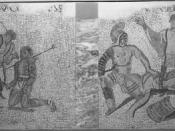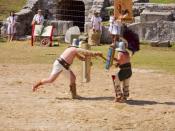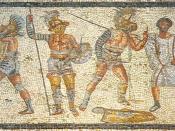Throughout Roman history, gladiatorial events were one of Rome's most desired pastimesports. The evolution of this deadly sport is fascinating itself. Emperors as well as civilizedcitizens would often come to the arena for entertainment and to relax as well. Since the citizen'sgovernment and community were mainly focused on conquering at that time, whether it was acountry or person, the hosts of the show or known as managers would often put up gladiatorialfights to satisfy the public (Meijer 152). These men that fought were consisted of prisoners ofwar or men who volunteered to take part of the familia gladiatoria hoping to find a better way tolive. To understand why this sport was one of Rome most desired past time activity, one mustfirst examine how: how someone becomes a gladiator, how they lived their lives, and what typeof games they partook in. When one scrutinizes these aspects before hand, it will be clearlyshown why these men were considered as celebrities to the spectators.
Gladiator fights were first introduced to Rome in 264 BC, when the sons of Junius Brutuspaid honor to their father's funeral by showing three pairs of gladiators fight (Baker 67). Thisritual caught on and was performed to honor significant men. As the years passed, theceremonies became more promoted and emperors began to present the games to symbolize theirpower. The citizens of Rome loved to go to these bloody warfares. In the city of Rome, theseevents were held in the Colosseum. This arena was so large that it could hold fifty thousandspectators and host fights between men and animals (Meijer 56). Gladiatorial games occupied acentral role in society. Sponsored during the republic by rich magistrates and later in the Empireby the Emperors themselves, the games have long been called an election tool. The games inRome are known today as the bloodiest exhibitions of public entertainment known to mankind.
Men, Women and children flocked to the Colosseum to watch the bloodthirsty fighters murderone another. The spectators came from all over the Roman Empire and various other regions,like Africa. The games became a way of entertaining the wealthy, as well as the common people.
The time in which a gladiator agrees to join the familia gladiatoria is one key event in a man'slife. "Gladiator", comes from the Latin word "gladius", for sword. They were primarily made upof slaves, criminals, prisoners of war or even men who volunteered. The crimes that could leadone to the arena included treason, robbery, and murder, among others. Some free men becamegladiators of their own free will in hopes of gaining notoriety and patronage amongst the wealthycitizens. By the end of 50 BC almost half of the gladiators fighting in the Colosseum were freemen. Since unemployed and under employed men couldn't make one a decent living, theresecondary choice would be to apply at the local gladiator school (Baker 85). Volunteers as ex-soldiers would also join because they didn't know how to live in the civilized world (Meijer 39).
This was probably due to the different rules in the familia gladiatoria compared to the outsideworld. If these men wanted to join the gladiator family, they would have to agree to an oath thatdeclared that their personal life would end. This meant that managers would have the full right tosell, trade or rent the gladiators out to the shows. Prisoners of war that choose to join thegladiator family would be forced to take the gladiator oath unwillingly of their circumstance.
Once a gladiator wins his duels and earned the favor of the emperor and the citizens for hisoutstanding performance, the emperor would offer him a great amount of goods. The editors ofthe show would also give the winners: gold, gifts, and money for a bonus (Baker 86). If he stillprogresses defeating other men in his career, the amount of gifts increases to an extreme value.
However on the other hand of the spectrum, prisoners who chose death instead ofapplying to the gladiator schools would be reserved for executions in the arenas. Since thecitizens of Rome wanted to see blood and death, the managers who were in charge of the showwould often execute prisoners during the break sessions. This kept the citizens sunk in theirseats, aroused and excited throughout the entire day. Such executions would be death by beast orad besias. This can be defined as when tigers, bears or lions were kept hungry until theexecutions so that they would pounce on their pray. Condemned slave would be tied down to acertain position formation so that the wild beasts could demolish their bodies into fragments. Thesecond type of death would be ad gladium, or death by the sword. This was known as a shortexecution. Lastly, the most haunting death one could face would be death on a cross, orcrucifixid. This, by far would be the most humiliating death one could face, seeing that the endwas coming ridiculously slow (Meijer 152).
For most men, gladiatorial life wasn't full of excitement but of hard work, consisted ofdaily training, exercise, and more training. As soon as one agrees to the gladiatorial oath, theywould be examined by a trained doctor who will choose the kind of equipment one will partake.
When the doctor choose what type of weapons a prisoner would be good at, he would send wordto the manager to see if he would accept it. For most of the time, managers and doctors wouldintend to agree with each other (Hoad 2). Afterwards, when the prisoners were assigned to theirtype of weapon they would use in the arena, the managers of the familia gladiatoria wouldchoose a specific trainer, which would accompany the young man throughout his course ofgladiatorial life. During their time at the schools, gladiators' daily life would be consisted of hardtraining from sun up to sun down. These gladiators would practice with wooden weapons insteadof battle ready weapons so that there would be a minimal chance of a revolt (Fowler). Practicewas done on a wooden post coming up from the ground, or on a 1-on-1 mini duel. This would bethe time when they would strengthen their footwork and gain incurrence. The pre weapons alongwith the shields and breast guard would be three times heavier than the original battle weaponsthat they would use in the arena. All of these factors benefitted the gladiators in the arena so thatthe battles could last longer, meaning that it will be bloodier and gruesome. This of course iswhat the spectators wanted to see. Before gladiators would be summoned to fight on the stage,the members of the familia gladiatoria would summon prayers for the young lad, asking theregods to protect the man from death. Most gladiators that lost prior battles would often be scaredout of their minds. These men were frightened of dying on the arena or by wild animals becausethey knew that it was disgraceful and dishonorable to die shamefully. Due to this fear in theirspirits, gladiators would commit acts such as committing suicide before there called(Ablemedia). When a gladiator has a mindset that he will conquer his opponents, he will have a10% chance that he will die on the field. However, if a gladiator lost a battle prior to his presentduel, he will have a 25% chance of death. A great part of your duel depends on what kind ofmindset you have (Meijer 42).
The last important aspect of gladiatorial fights is the different types of games thatgladiators were offered. There were three common types of events: sodalities (one-on-one),venatorum (hunting), and sea battles. Although some gladiators fought wild animals, the combatsusually featured a pair of male human contenders. They fought in diverse styles depending ontheir background and how much training they had endured. Originally as captured soldiers, theywere made to fight with their own weapons. The sodalitas venatorum were competitions inwhich skilled archers and javelin throwers would try to compete for a one shot clean kill usinglive animals as targets. These men would start off by letting loose a vast amount of differentherbivore animals such as deer, stag, goats etc. Afterwards, these hunters would chase thesevictims around the arena slaughtering each one, one by one with their weapons. As soon as theseanimals were all lying dead on the ground, a cleanup crew would be summoned to go clean thearena. Afterwards, the emperor would give the sign for more animals to be released in the arena.
The dead carcasses would be disposed of or given to the gladiators as food so that the managerswouldn't have to shell out money from their pockets. For the second part of the day, wild beastssuch as lions, cougars, and hippos would be released in the arena. The venators would then haveto defend themselves with their javelins and shields. The bloodshed which took place in theColosseum, was not however, always hailed as a good sport. Many people, including one of theearliest Greek apologists, Tatian, in the mid-second century, has to be seen as part of a widerattack on pagan rituals, calling the games, "despicable and defiled. In 55 B.C, Pompey of Romeorganized a scdalitas venatorum show in the Circus Maximus where 20 ferocious elephants werebeing chased by venators. When the crowd saw that these great beasts were being tortured andabused, the spectators felt more lenient to the animals, rather to the men fighting to escape death.
From this, the emperors of Rome chose to stay away from slaughtering so many animals so thatthey would not loose there viewers. The second type of competition that was put out for thespectators was either one-on-one hand combat or a group of gladiators vs. another group. Inthese types of battles, the winners would rank up his skill and victories, hoping that the emperorwill find favor with him. The loser would usually, but not often die. However, in some cases,when the loser has acted courageously and boldly, the emperor along with the crowd wouldagree to spare his life. The third type of shows that wasn't as common, but very popular was seabattles. This is when large and spacious arenas would have dirt removed from the floor and sealup the inside so that water wouldn't leak outside. Once the hole was big enough for ships to fit,boats such as triremes and quadriremes would be put in the arena. After the boats have beenassembled, the water would be placed in filling up the arena like a small lake. On the day of thegladiator shows, massive fleets of five thousand oarsmen and soldiers would be put on differentboats to rein act a common sea battle. The largest sea battle reenactment that ever took place wasin 52 A.D. during the reign of Emperor Claudius. This battle consisted of nineteen thousand oarsmen, and gladiators. Usually, when the men were chosen for Claudius' sea battles, the gladiatorswould solute the emperor saying "Aue Caesar, morituri te salutant;" ("Hail, Caesar, those whoare about to die solute you"). Caesar in return responded back saying, "Aut non," ("or no"t),whereupon the men thought that they were free, so they decided to forgo the battle. Caesar, notknowing either to burn them ore hang them finally convinced them to fight stating that there willbe a massive reward for the winners in the end. These games continued from dawn to dusk andlasted for many days. The imperial games would sometimes exhibit thousands of gladiators in asequence that could last for several months.
The Roman gladiator fights were the most violent, bloodiest sports, ever to have beencreated in our entire history, killing thousands of people and animals for the sake ofentertainment. However, it was also responsible for influencing many of the more passivepopular sports we have today. The Romans were living in a time, when most of the governmentand community were mainly focused on conquering, whether it was a country or person. TheColosseum was a way for Rome to demonstrate to the eager population the power and glory ofthe Roman Empire. This sport wasn't invented for the gladiators to have fun but rather to duel tothe finish, putting to test all of your experience that you gained from the gladiator school, hopingthat one day freedom will come. That is what the sport was thought as from a gladiator'sperspective, history's most deadly sport.
Works CitedBaker, Alan. The Gladiator: The Secret History of Rome's Warrior slaves. New York City: Da Capo Press,2002.
Fowler, Robin. "Gladiator." The Concise Oxford Dictionary of English Etymology. 30 March, 2009. 1996.
Gladiatorial Training & Combat. The Roman Gladiator. 2007. AbleMedia LLC. 30 March.
.
Meijer, Fik. The Gladiators: history's Most deadly Sport. Netherlands: Atheneum-Polak and Van GnnepAmsterdam, 2003.
T. F. Hoad. "Gladiatorial Training and Combat." 30 March, 2009. Encyclopedia: Gladiator. April 5, 2006.
.

![Villa Borghese gladiator mosaic Español: (obitus)// Iaculator// [------]/ Rodan[---]](https://s.writework.com/uploads/1/15381/villa-borghese-gladiator-mosaic-espanol-obitus-iaculator-rod-thumb.jpg)



